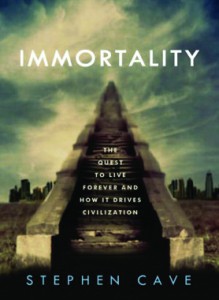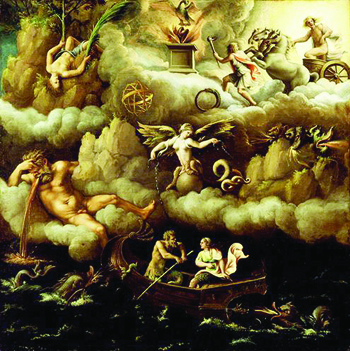Immortality: The Quest to Live Forever and How It Drives Civilization

There’s a tendency among humanist and atheist writers to make their books dense and detailed, recognizing that the usual audience wants all the facts comprehensively collected in one place. Their readers may not need or even desire the many popular approaches to storytelling, such as creating suspense or tossing in entertaining sidelights to stir interest in the content. Those who just want to “get the information” tend to grow impatient with all that. I know I do.
But this isn’t the case with every candidate for a humanist worldview, or aspects of it. In particular, many aren’t yet sure what philosophical conclusions to draw; so they need to be gently sold rather than bombarded with arguments. Thus they can be put off by books that seem too heavy, or that sound too decisive and settled from the get-go.
British writer Stephen Cave, who got his PhD in metaphysics from Cambridge University, understands this. As such he’s written a book, innocuously titled Immortality: The Quest to Live Forever and How It Drives Civilization, designed to impart to a wider public a portion of the humanist outlook—the idea that no form of immortality is truly attainable. It’s a book crafted to reach beyond the audience included within the current humanist movement. This becomes clear not only from his title but from the first sentence. Cave starts out by taking us on a journey to ancient Egypt, opening the first chapter, “A Beautiful Woman Has Come,” with a paragraph that could have begun a popular novel.
They tried to destroy her. Hammers swung to smash the elegant nose and break her long and graceful neck. All across the kingdom, the statues and busts of the great queen were pounded to dust. Her name was chiseled from the monuments, its utterance banned. This embodiment of regal womanhood was never to be seen or spoken of again.
For many, that sort of nonfiction writing is exciting. It gets the juices flowing and draws one into the material. Now compare the above passage about Nefertiti to the opening of the only other major book devoted exclusively to a careful analysis of life after death: Corliss Lamont’s The Illusion of Immortality. Chapter One is entitled “Importance of the Problem” and starts thus:
“All men are mortal” begins the most famous of all syllogisms, and it proceeds to tell us that “Socrates is a man” and “therefore Socrates is mortal.” The branch of philosophy known as logic has made much of this syllogism as an example of perfect reasoning; what is more significant is the prodigious amount of time and energy which philosophy as a whole has spent on inquiring into its true and complete meaning.
And so the first paragraph goes, continuing for four more long and complex sentences. Which is appropriate for a book that originated as a doctoral dissertation.
 Cave relies heavily on Lamont and gives him due credit. But he reorganizes Lamont’s essential arguments (and those of others) in a particularly memorable way, reducing “the apparent diversity of stories about how immortality is to be attained” to four basic narratives: staying alive, resurrection, soul, and legacy. He then begins his exploration of the staying-alive narrative with the story of the first emperor of China and that man’s pursuit of an elixir of life that would allow him to live forever. Cave wraps up with modern techno-optimist and transhumanist ideas of nanotechnology and life extension, revealing their many hidden problems.
Cave relies heavily on Lamont and gives him due credit. But he reorganizes Lamont’s essential arguments (and those of others) in a particularly memorable way, reducing “the apparent diversity of stories about how immortality is to be attained” to four basic narratives: staying alive, resurrection, soul, and legacy. He then begins his exploration of the staying-alive narrative with the story of the first emperor of China and that man’s pursuit of an elixir of life that would allow him to live forever. Cave wraps up with modern techno-optimist and transhumanist ideas of nanotechnology and life extension, revealing their many hidden problems.
For the resurrection narrative he begins with the New Testament and Paul’s resurrection of the flesh doctrine, takes us through Mary Shelley’s Frankenstein, analyzes cryonics, and leaves off where Star Trek “beams down” Captain Kirk. All the while Cave exposes the internal contradictions that are rife within any idea of achieving immortality in such a manner.
The soul narrative begins with Dante, provides the usual philosophic objections to the very idea of a soul, explores reincarnation, and challenges Buddhism head on, refuting its claim that the soul narrative is not part of its doctrine.
This leaves the concept of legacy: living on in the memories of others. Although I’m disappointed that Cave doesn’t note the arguments on this topic so evocatively presented by Cicero in “Scipio’s Dream,” I enjoyed the historical coverage of the immortal aspirations of Alexander of Macedon and the legendary ones of Homer’s heroes. Cave also covers a variation on this narrative, which he calls “biological legacy,” poetically expressed by Albert Einstein when writing to console a friend’s widow. “Our death is not an end if we can live on in our children, for they are us,” Einstein wrote. “Our bodies are only wilted leaves on the tree of life.” But it turns out there’s a dark side to this view, which takes us back to Alexander and the palace murders orchestrated by his mother, Olympias.
What Cave does so well throughout Immortality is to take the reader by the hand and carefully guide her or him through each concept, ensuring understanding before exploring assorted variations and difficulties. He’s writing for searchers, not people collecting knock ’em-dead refutations of positions they’ve already rejected. And his appeal is to intellectual curiosity. The vehicle by which he transports readers through the maze of cultural assumptions and theological abstractions is that of the humanities. Science has its say, to be sure. But he doesn’t require readers to start from such a perspective.
Cave is a storyteller, and he uses stories as entrées to ideas. Most people respond much better to stories than to clinical dissections. That’s the secret of the Bible’s popularity, for instance. It’s more a storybook than a law book—and certainly isn’t a text on theology or science. So if humanism hopes to compete in that marketplace, it will need to tell stories too—true stories as well as literary ones.
Just as importantly, Cave understands the psychology behind belief in an afterlife. So he takes readers into the depths of the “mortality paradox,” explaining how it’s possible that, on the one hand, we know we will die and, on the other, we just can’t imagine ourselves dead. By revealing and parsing this paradox, he takes us to the root of the issue.
Then, in the final section of the book, he sets forth a positive vision of the good life free of immortal aspirations. As usual, Cave infotains us first, this time with the Sumerian Epic of Gilgamesh and its message that a person would do better to focus on the here and now. Then he takes us through Epicurus and brings us to the life-affirming wisdom of the Stoics, Bertrand Russell, and others.
It isn’t enough, you see, to simply tear down a false idea. One needs to also offer a positive alternative. Lamont knew the value of this approach, naming his final chapter “Life without Immortality” and offering an affirmative humanism. Cave does much the same thing. But he does it without any specific reference to humanism, freethought, or atheism—words that, indeed, are totally absent from his index.
And therein lies the rub. Cave has written a book that doesn’t label its source or conclusion. For some this will prove a major shortcoming, for others an ethical lapse. But could it simply be a deft communication of controversial ideas? I’ll leave it for those reading the book to decide for themselves.
